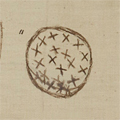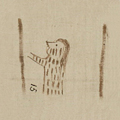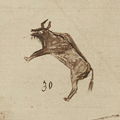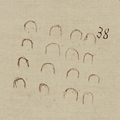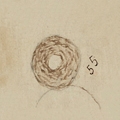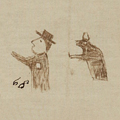Glyph 15 | 1837
Wičháȟaŋȟaŋ tȟaŋká
(Smallpox big)
There was an epidemic of smallpox.
Smallpox epidemics had already twice hit Native tribes of the Upper Missouri, including the Mandan, Hidatsa, and Arikara before the epidemic of 1837. The epidemic of 1833 spread through Fort Clark, a fur trading post built in 1823 near the junction of the Knife River and the Missouri River. Mandan, Arikara, Hidatsa, Yanktonai, Crow, and Assiniboine as well as other tribes would travel to Fort Clark to trade buffalo robes and furs for tobacco, guns, cloth, and other goods. During the summer of 1837 a steamboat called St. Peters traveled up the river with goods. Passengers were infected with smallpox and it spread among tribes in the area becoming one of the deadliest epidemics of the West, killing approximately 17,000 people across several tribes including ninety percent of Mandan people, half of Arikara people, and at least 400 Yanktonai. Many people also committed suicide as a response to the despair that ensured from the epidemic.
Elsewhere in the world:
The Adventures of Oliver Twist is published by Charles Dickens

